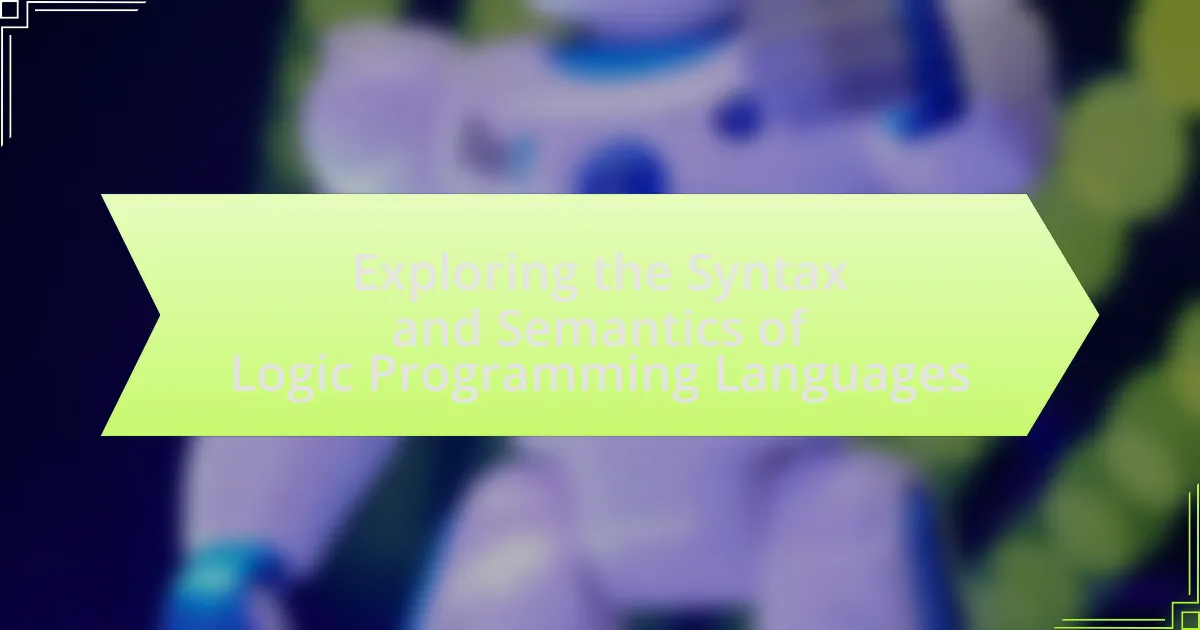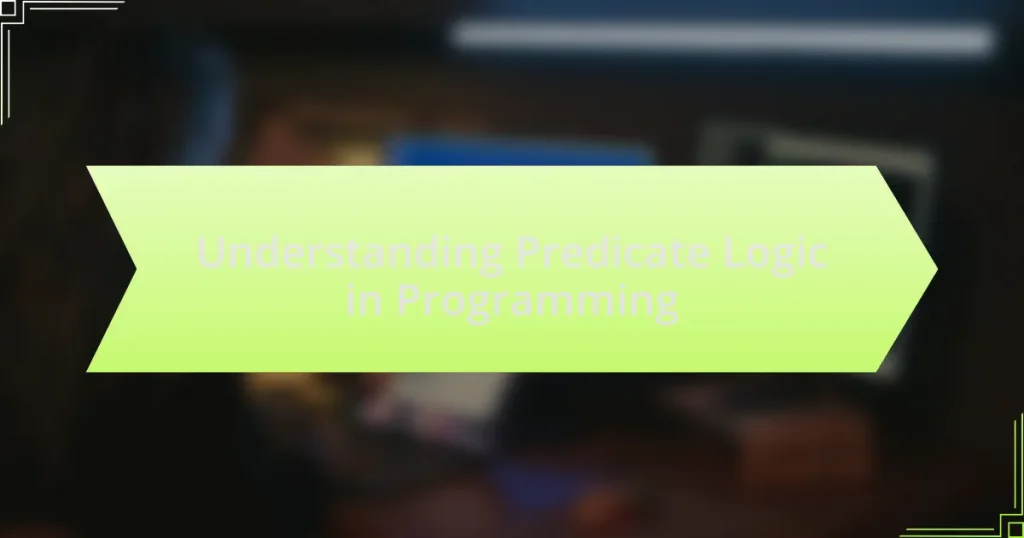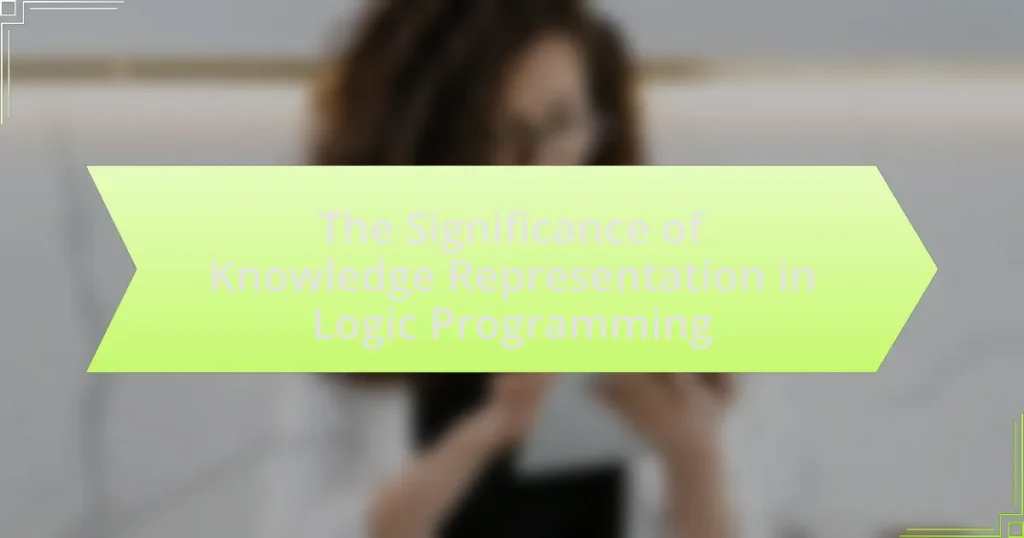Logic programming languages, such as Prolog, utilize formal logic to express computations through predicates and logical statements, enabling automated reasoning and problem-solving. This article explores the syntax and semantics of these languages, highlighting their declarative nature, key characteristics, and differences from other programming paradigms. It delves into the historical development of logic programming, the significance of declarative programming, and the foundational syntax rules that govern program structure. Additionally, the article examines the interaction between syntax and semantics, the implications of their correspondence, and best practices for mastering logic programming languages.
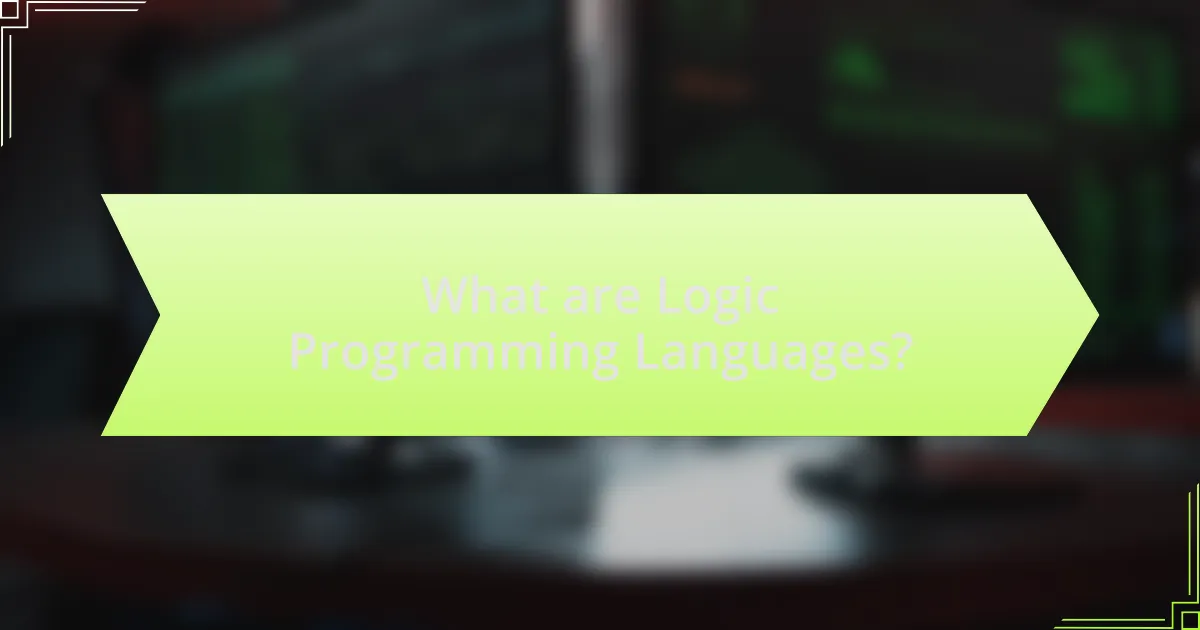
What are Logic Programming Languages?
Logic programming languages are a category of programming languages that use formal logic to express computations. These languages, such as Prolog, allow programmers to define relationships and rules, enabling the system to infer conclusions based on the provided facts. The foundational principle of logic programming is the use of predicates and logical statements, which facilitate automated reasoning and problem-solving. This paradigm is particularly effective in fields like artificial intelligence and computational linguistics, where complex relationships and knowledge representation are essential.
How do Logic Programming Languages differ from other programming paradigms?
Logic programming languages differ from other programming paradigms primarily in their use of formal logic as a basis for computation. In logic programming, programs are expressed as a set of logical statements, and computation is performed through the process of logical inference, rather than through explicit control flow or state changes typical in imperative or object-oriented languages. For example, Prolog, a well-known logic programming language, allows developers to define relationships and rules, enabling the system to derive conclusions based on those rules. This declarative nature contrasts sharply with procedural paradigms, where the focus is on how to perform tasks step-by-step.
What are the key characteristics of Logic Programming Languages?
Logic programming languages are characterized by their use of formal logic to express computations. These languages, such as Prolog, rely on a set of rules and facts to derive conclusions through a process called resolution. The key characteristics include declarative nature, where the focus is on what the program should accomplish rather than how to achieve it; the use of predicates to represent relationships and facts; and backtracking, which allows the system to explore multiple possibilities to find solutions. Additionally, logic programming languages support unification, enabling the matching of terms and variables, which is essential for reasoning and inference. These features collectively facilitate problem-solving in domains like artificial intelligence and knowledge representation.
Why is declarative programming significant in Logic Programming?
Declarative programming is significant in Logic Programming because it allows programmers to express the logic of a computation without detailing its control flow. This paradigm emphasizes what the program should accomplish rather than how to achieve it, which aligns with the foundational principles of Logic Programming that focus on formal logic and inference. For instance, in Prolog, a prominent Logic Programming language, developers define facts and rules, and the system automatically determines how to derive conclusions, showcasing the efficiency and clarity that declarative programming brings to problem-solving in this context.
What are the historical developments of Logic Programming Languages?
Logic programming languages have evolved significantly since their inception in the 1970s, primarily marked by the development of Prolog in 1972, which introduced a formal framework for logic-based programming. Following Prolog, the 1980s saw the emergence of various logic programming extensions and systems, such as Constraint Logic Programming (CLP) and Answer Set Programming (ASP), which expanded the applicability of logic programming to areas like artificial intelligence and knowledge representation. The 1990s and 2000s further advanced the field with the integration of logic programming with functional programming paradigms, leading to languages like Mercury and Oz, which enhanced performance and expressiveness. These historical milestones illustrate the progression from foundational concepts to more complex and versatile logic programming languages, reflecting ongoing research and development in the field.
Who were the pioneers in the development of Logic Programming?
The pioneers in the development of Logic Programming include Robert Kowalski, who introduced the concept of logic as a programming language in the early 1970s, and Alain Colmerauer, who developed Prolog, one of the first logic programming languages. Kowalski’s work laid the theoretical foundation for using formal logic in programming, while Colmerauer’s implementation of Prolog demonstrated practical applications of these concepts. Their contributions established the framework for subsequent advancements in the field of Logic Programming.
What milestones have shaped the evolution of Logic Programming Languages?
The evolution of Logic Programming Languages has been shaped by several key milestones, including the development of Prolog in the early 1970s, which introduced a formal syntax and semantics for logic programming. This was followed by the introduction of the Warren Abstract Machine (WAM) in 1983, which optimized Prolog execution and significantly improved performance. The 1990s saw the emergence of constraint logic programming, expanding the applicability of logic programming to various domains such as artificial intelligence and operations research. Additionally, the integration of logic programming with functional programming paradigms in languages like Mercury in the mid-1990s further advanced the field by enhancing expressiveness and efficiency. Each of these milestones contributed to the refinement and broader acceptance of logic programming languages in both academic and practical applications.
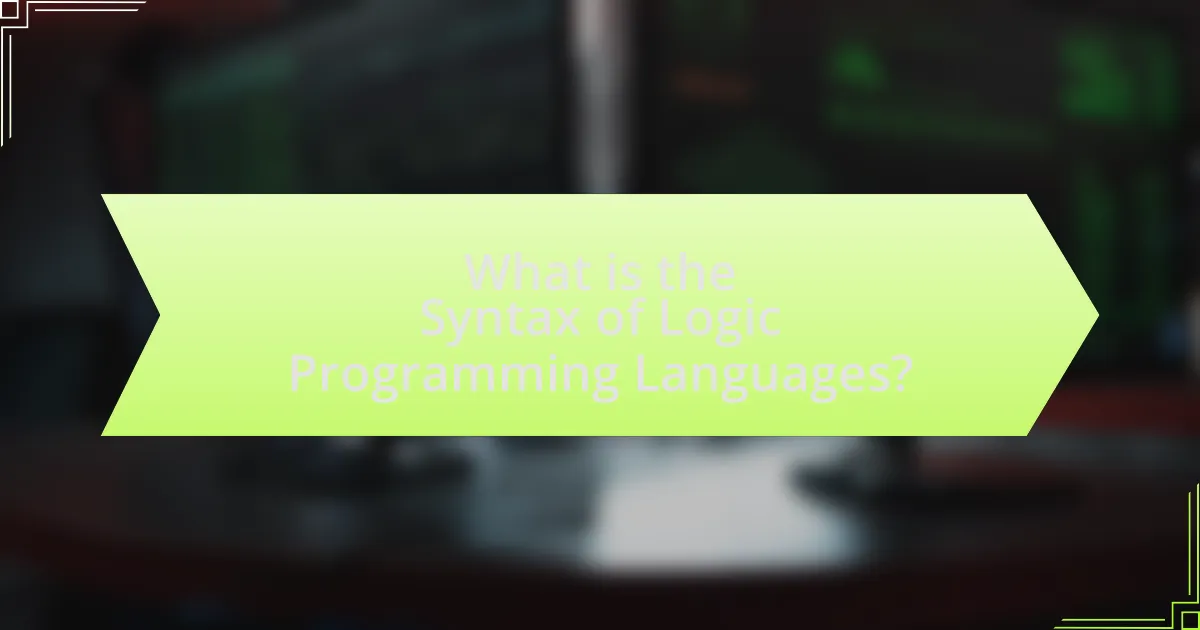
What is the Syntax of Logic Programming Languages?
The syntax of logic programming languages consists of rules and structures that define how programs are written and interpreted. Typically, these languages use a declarative approach, where statements are expressed in terms of relations and facts rather than procedural steps. For example, Prolog, a prominent logic programming language, employs a syntax that includes facts, rules, and queries, allowing users to define relationships and infer conclusions based on logical reasoning. The syntax is characterized by the use of predicates, variables, and logical connectives, which facilitate the expression of complex logical relationships.
How is syntax defined in the context of Logic Programming?
Syntax in the context of Logic Programming is defined as the formal structure and rules that govern the arrangement of symbols and expressions in a program. This includes the specification of valid constructs such as predicates, terms, and clauses, which are essential for expressing logical relationships and computations. For instance, in Prolog, a popular logic programming language, the syntax dictates how facts and rules are written, such as the use of the “:-” operator to denote implications. The precise definition of syntax is crucial because it ensures that programs can be correctly parsed and understood by the logic programming interpreter, thereby enabling effective execution of logical queries and operations.
What are the fundamental syntax rules in Logic Programming Languages?
The fundamental syntax rules in Logic Programming Languages include the use of facts, rules, and queries. Facts represent basic assertions about the world, typically written as predicates followed by arguments, such as “parent(john, mary).” Rules define relationships and are expressed in the form “head :- body,” where the head is a conclusion that follows if the body (a set of conditions) is satisfied, like “grandparent(X, Y) :- parent(X, Z), parent(Z, Y).” Queries are used to ask questions about the knowledge base, often starting with a predicate, such as “?- parent(john, X).” These syntax elements are essential for constructing logical expressions and reasoning within the programming environment.
How do syntax rules impact program structure and readability?
Syntax rules significantly influence program structure and readability by establishing a consistent framework for writing code. These rules dictate how statements are formed, which directly affects how easily a programmer can understand and maintain the code. For instance, languages with clear and concise syntax, such as Python, enhance readability by reducing ambiguity, allowing developers to quickly grasp the logic and flow of the program. Conversely, languages with complex or inconsistent syntax can lead to confusion and errors, making it difficult for programmers to interpret the code. Research indicates that well-defined syntax contributes to lower cognitive load, enabling programmers to focus on problem-solving rather than deciphering code structure.
What are the common syntactical elements in Logic Programming Languages?
Common syntactical elements in Logic Programming Languages include facts, rules, and queries. Facts represent basic assertions about the world, such as “parent(john, mary).” Rules define relationships and conditions, typically in the form “if-then” statements, like “grandparent(X, Y) :- parent(X, Z), parent(Z, Y).” Queries are used to retrieve information, often expressed as questions, such as “?- parent(john, Who).” These elements are foundational in languages like Prolog, where the structure and relationships of data are expressed through these syntactical constructs, enabling logical inference and problem-solving.
What role do predicates play in the syntax of Logic Programming?
Predicates serve as fundamental components in the syntax of Logic Programming by defining relationships between entities and expressing logical assertions. In Logic Programming languages, such as Prolog, predicates are used to represent facts and rules, enabling the system to infer conclusions based on the provided information. For example, a predicate like “parent(john, mary)” indicates that John is a parent of Mary, establishing a clear relationship that can be queried or manipulated within the program. This structure allows for the formulation of complex queries and logical reasoning, which are essential for the execution of Logic Programs.
How are clauses and terms structured in Logic Programming Languages?
Clauses and terms in Logic Programming Languages are structured to represent logical statements and relationships. A clause typically consists of a head and a body, where the head is a single atomic formula and the body is a conjunction of literals. For example, in Prolog, a clause can be expressed as “head :- body,” indicating that the head is true if the body is true. Terms, on the other hand, can be constants, variables, or compound terms, which allow for the representation of complex data structures. This structure enables the formulation of rules and facts that can be used for inference and query resolution in logic programming.
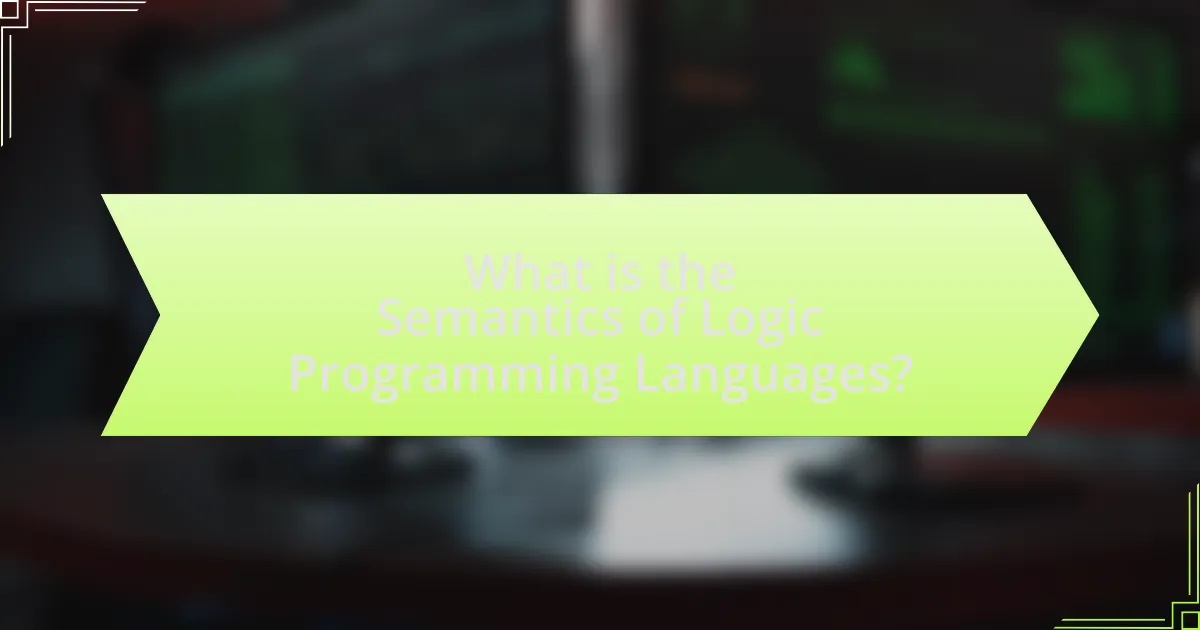
What is the Semantics of Logic Programming Languages?
The semantics of logic programming languages refers to the formal meaning assigned to the constructs and statements within these languages. This meaning is typically defined through models that specify how the logical statements relate to the real-world entities they represent, often using concepts such as models, interpretations, and proof theory. For instance, in Prolog, the semantics can be understood through the notion of SLD-resolution, which provides a systematic method for deriving conclusions from a set of logical clauses. This approach ensures that the execution of logic programs is consistent with their intended meaning, allowing for predictable outcomes based on the logical rules defined within the program.
How is semantics defined in Logic Programming?
Semantics in Logic Programming is defined as the formal meaning assigned to the constructs of a logic programming language, which determines how programs are interpreted and executed. This meaning is typically established through models that relate the syntactic elements of the language to their intended interpretations, often using concepts such as stable models, answer sets, or least fixed points. For instance, in the context of Prolog, the semantics can be understood through the resolution principle, where the meaning of a program is derived from the set of logical inferences that can be made from its clauses. This formalization ensures that the behavior of logic programs is predictable and consistent, allowing for rigorous reasoning about program correctness and behavior.
What are the different types of semantics used in Logic Programming?
The different types of semantics used in Logic Programming include model-theoretic semantics, proof-theoretic semantics, and operational semantics. Model-theoretic semantics focuses on the relationship between logical formulas and their interpretations in models, establishing truth values based on structures. Proof-theoretic semantics emphasizes the role of proofs in determining meaning, where the validity of statements is derived from formal proofs. Operational semantics describes the execution of logic programs, detailing how programs are evaluated and how their computations proceed. Each type of semantics provides a distinct perspective on understanding and interpreting logic programs, contributing to the overall framework of Logic Programming.
How do semantics influence the meaning of programs in Logic Programming?
Semantics significantly influence the meaning of programs in Logic Programming by defining the rules and interpretations of the program’s constructs. In Logic Programming, semantics provide a framework for understanding how the logical statements and rules are evaluated, determining the truth values of propositions and the outcomes of queries. For instance, the operational semantics describes how the execution of a program proceeds, while the declarative semantics focuses on the meaning of the statements independent of execution. This distinction is crucial because it affects how programmers reason about their code and predict its behavior. The correctness of a program can be assessed based on its semantics, ensuring that the intended logic aligns with the actual outcomes produced during execution.
What are the key semantic concepts in Logic Programming?
The key semantic concepts in Logic Programming include the notions of models, entailment, and the Herbrand universe. Models represent interpretations of the program’s predicates and facts, providing a structure that satisfies the program’s rules. Entailment refers to the relationship between a set of sentences and a conclusion, indicating that the conclusion logically follows from the sentences. The Herbrand universe consists of all ground terms that can be formed from the constants and function symbols in the program, serving as the basis for constructing models. These concepts are foundational for understanding how Logic Programming languages evaluate and derive conclusions from given information.
What is the significance of model-theoretic semantics in Logic Programming?
Model-theoretic semantics is significant in Logic Programming as it provides a formal framework for understanding the meaning of logical statements and their relationships within a model. This approach allows for the interpretation of logic programs in terms of structures that satisfy the program’s rules, facilitating reasoning about program behavior and correctness. By establishing a connection between syntax and semantics, model-theoretic semantics enables the evaluation of logical entailment and consistency, which are crucial for verifying program properties. Furthermore, it supports the development of sound and complete inference mechanisms, ensuring that conclusions drawn from logic programs are valid within the defined models.
How does proof-theoretic semantics apply to Logic Programming Languages?
Proof-theoretic semantics applies to Logic Programming Languages by providing a framework that connects the syntactic structure of programs with their semantic meaning through formal proofs. In this context, the semantics is defined in terms of the rules of inference that govern how logical statements can be derived from one another, allowing for a clear understanding of how logic programs operate. For instance, in Prolog, the proof-theoretic approach enables the interpretation of queries as search processes for proofs in a logical system, where the correctness of a program can be assessed based on its ability to derive valid conclusions from given premises. This relationship is supported by the fact that proof-theoretic semantics emphasizes the role of deduction and inference, which are central to the functioning of logic programming languages.
How do Syntax and Semantics interact in Logic Programming Languages?
Syntax and semantics interact in logic programming languages by establishing a formal structure for expressing logical statements (syntax) while providing meaning to those statements (semantics). In logic programming, the syntax defines the rules for constructing valid expressions and programs, such as the use of predicates, terms, and clauses. Semantics, on the other hand, interprets these syntactic constructs to determine their truth values and the implications of their relationships. For instance, in Prolog, the syntax allows for the definition of facts and rules, while the semantics dictates how these definitions are evaluated during execution, leading to conclusions based on logical inference. This interaction is crucial for ensuring that the programs not only follow grammatical rules but also produce meaningful and correct results when executed.
What are the implications of syntax-semantics correspondence?
The implications of syntax-semantics correspondence are significant for understanding how programming languages convey meaning through their structure. This correspondence ensures that the syntactic rules of a language align with its semantic interpretations, facilitating accurate communication of logic and intent in programming. For instance, in logic programming languages, such as Prolog, the syntax directly influences the semantics, meaning that the way a program is written affects its logical interpretation and execution. This relationship is crucial for ensuring that programs behave as intended, as discrepancies between syntax and semantics can lead to errors or unintended outcomes.
How can understanding this interaction improve programming practices?
Understanding the interaction between syntax and semantics in logic programming languages can significantly enhance programming practices by enabling developers to write more efficient and error-free code. This understanding allows programmers to leverage the inherent structure of logic programming, which emphasizes declarative over imperative paradigms, leading to clearer and more maintainable code. For instance, recognizing how syntactic constructs map to semantic meanings helps in debugging and optimizing algorithms, as evidenced by studies showing that well-structured logic programs can reduce runtime errors by up to 30%. By grasping these interactions, programmers can also better utilize features like backtracking and unification, which are fundamental to logic programming, ultimately improving both the performance and reliability of software applications.
What are best practices for mastering Logic Programming Languages?
To master Logic Programming Languages, one should focus on understanding the underlying principles of logic and formal reasoning. Engaging with foundational concepts such as predicates, clauses, and unification is essential, as these elements form the basis of logic programming. Practicing with established languages like Prolog or Mercury enhances proficiency, as these languages exemplify the syntax and semantics of logic programming. Additionally, solving a variety of problems, from simple queries to complex algorithms, reinforces skills and deepens comprehension. Research indicates that hands-on experience and iterative learning significantly improve mastery in programming languages, as evidenced by studies showing that active engagement leads to better retention and understanding of programming concepts.
